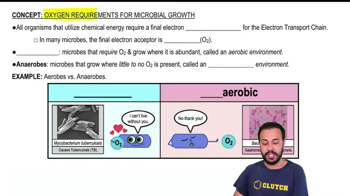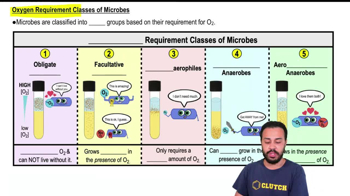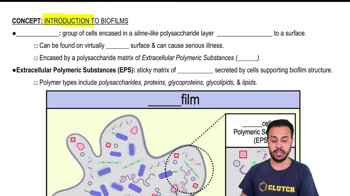Table of contents
- 1. Introduction to Biology2h 42m
- 2. Chemistry3h 40m
- 3. Water1h 26m
- 4. Biomolecules2h 23m
- 5. Cell Components2h 26m
- 6. The Membrane2h 31m
- 7. Energy and Metabolism2h 0m
- 8. Respiration2h 40m
- 9. Photosynthesis2h 49m
- 10. Cell Signaling59m
- 11. Cell Division2h 47m
- 12. Meiosis2h 0m
- 13. Mendelian Genetics4h 44m
- Introduction to Mendel's Experiments7m
- Genotype vs. Phenotype17m
- Punnett Squares13m
- Mendel's Experiments26m
- Mendel's Laws18m
- Monohybrid Crosses19m
- Test Crosses14m
- Dihybrid Crosses20m
- Punnett Square Probability26m
- Incomplete Dominance vs. Codominance20m
- Epistasis7m
- Non-Mendelian Genetics12m
- Pedigrees6m
- Autosomal Inheritance21m
- Sex-Linked Inheritance43m
- X-Inactivation9m
- 14. DNA Synthesis2h 27m
- 15. Gene Expression3h 20m
- 16. Regulation of Expression3h 31m
- Introduction to Regulation of Gene Expression13m
- Prokaryotic Gene Regulation via Operons27m
- The Lac Operon21m
- Glucose's Impact on Lac Operon25m
- The Trp Operon20m
- Review of the Lac Operon & Trp Operon11m
- Introduction to Eukaryotic Gene Regulation9m
- Eukaryotic Chromatin Modifications16m
- Eukaryotic Transcriptional Control22m
- Eukaryotic Post-Transcriptional Regulation28m
- Eukaryotic Post-Translational Regulation13m
- 17. Viruses37m
- 18. Biotechnology2h 58m
- 19. Genomics17m
- 20. Development1h 5m
- 21. Evolution3h 1m
- 22. Evolution of Populations3h 52m
- 23. Speciation1h 37m
- 24. History of Life on Earth2h 6m
- 25. Phylogeny2h 31m
- 26. Prokaryotes4h 59m
- 27. Protists1h 12m
- 28. Plants1h 22m
- 29. Fungi36m
- 30. Overview of Animals34m
- 31. Invertebrates1h 2m
- 32. Vertebrates50m
- 33. Plant Anatomy1h 3m
- 34. Vascular Plant Transport1h 2m
- 35. Soil37m
- 36. Plant Reproduction47m
- 37. Plant Sensation and Response1h 9m
- 38. Animal Form and Function1h 19m
- 39. Digestive System1h 10m
- 40. Circulatory System1h 57m
- 41. Immune System1h 12m
- 42. Osmoregulation and Excretion50m
- 43. Endocrine System1h 4m
- 44. Animal Reproduction1h 2m
- 45. Nervous System1h 55m
- 46. Sensory Systems46m
- 47. Muscle Systems23m
- 48. Ecology3h 11m
- Introduction to Ecology20m
- Biogeography14m
- Earth's Climate Patterns50m
- Introduction to Terrestrial Biomes10m
- Terrestrial Biomes: Near Equator13m
- Terrestrial Biomes: Temperate Regions10m
- Terrestrial Biomes: Northern Regions15m
- Introduction to Aquatic Biomes27m
- Freshwater Aquatic Biomes14m
- Marine Aquatic Biomes13m
- 49. Animal Behavior28m
- 50. Population Ecology3h 41m
- Introduction to Population Ecology28m
- Population Sampling Methods23m
- Life History12m
- Population Demography17m
- Factors Limiting Population Growth14m
- Introduction to Population Growth Models22m
- Linear Population Growth6m
- Exponential Population Growth29m
- Logistic Population Growth32m
- r/K Selection10m
- The Human Population22m
- 51. Community Ecology2h 46m
- Introduction to Community Ecology2m
- Introduction to Community Interactions9m
- Community Interactions: Competition (-/-)38m
- Community Interactions: Exploitation (+/-)23m
- Community Interactions: Mutualism (+/+) & Commensalism (+/0)9m
- Community Structure35m
- Community Dynamics26m
- Geographic Impact on Communities21m
- 52. Ecosystems2h 36m
- 53. Conservation Biology24m
26. Prokaryotes
Prokaryotic Metabolism
Problem 2`
Textbook Question
Photoautotrophs use
a. Light as an energy source and CO₂ as a carbon source
b. Light as an energy source and methane as a carbon source
c. N₂ as an energy source and CO₂ as a carbon source
d. CO₂ as both an energy source and a carbon source
 Verified step by step guidance
Verified step by step guidance1
Understand the term 'photoautotrophs': These are organisms that use light energy to synthesize organic compounds from carbon dioxide. They are a type of autotroph, meaning they produce their own food.
Identify the energy source for photoautotrophs: Photoautotrophs use light as their energy source. This is a key characteristic that distinguishes them from other types of autotrophs.
Determine the carbon source for photoautotrophs: Photoautotrophs use carbon dioxide (CO2) as their carbon source. They convert CO2 into organic compounds through the process of photosynthesis.
Evaluate the options given in the problem: Compare each option to the characteristics of photoautotrophs. Option a states 'light as an energy source and CO2 as a carbon source,' which matches the definition of photoautotrophs.
Conclude which option correctly describes photoautotrophs: Based on the analysis, option a is the correct choice as it accurately describes the energy and carbon sources used by photoautotrophs.
 Verified video answer for a similar problem:
Verified video answer for a similar problem:This video solution was recommended by our tutors as helpful for the problem above
Video duration:
2mPlay a video:
Was this helpful?
Key Concepts
Here are the essential concepts you must grasp in order to answer the question correctly.
Photoautotrophs
Photoautotrophs are organisms that use light energy to synthesize organic compounds from carbon dioxide. They are a type of autotroph, meaning they produce their own food, and are crucial in ecosystems for converting solar energy into chemical energy through photosynthesis. Common examples include plants, algae, and certain bacteria.
Recommended video:
Guided course

Prokaryote Lineages 2
Photosynthesis
Photosynthesis is the process by which photoautotrophs convert light energy into chemical energy stored in glucose. It involves the absorption of light by chlorophyll, the splitting of water molecules, and the fixation of carbon dioxide into organic compounds. This process not only provides energy for the organism but also releases oxygen as a byproduct, essential for life on Earth.
Recommended video:
Guided course

Pigments of Photosynthesis
Carbon Source
In biological terms, a carbon source is a molecule that provides carbon atoms for the synthesis of organic compounds. For photoautotrophs, carbon dioxide (CO2) is the primary carbon source, which they fix into sugars during photosynthesis. Understanding the carbon source is crucial for distinguishing different types of autotrophs and their ecological roles.
Recommended video:
Guided course

Carbon

 2:57m
2:57mWatch next
Master Nutritional Factors of Microbial Growth with a bite sized video explanation from Jason
Start learningRelated Videos
Related Practice












